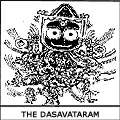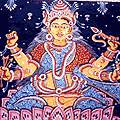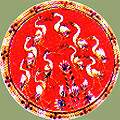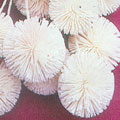Literally the cloth picture(s)/painting(s) of Odisha, the patachitras, according to O.C. Gangoly, represent (in their original form) the ‘icon paintings of Puri…of the Cult of Jagannath’. In Gangoly’s survey of Odishan paintings, patachitras or pata paintings are defined clearly as a ‘school of painting’ linked intimately with the cult of Lord Jagannath (a prominent and powerful deity) and with the Jagannath temple in Puri (Odisha).
I. ICONIC PAINTINGS: THE JAGANNATH CULT AND THE HISTORY OF PATACHITRAS
Maintaining that the origin of these iconic paintings is linked with the ‘…famous temple of Puri [that] was built by the Choda-Ganga-Deva’, Gangoly states the school ‘has been kept alive throughout the centuries by the demands of millions of pilgrims who flock to the shrine of Jagannath from all parts of India’. Mohanty traces the origins of pata paintings to the eighth century AD; apart from fragmentary evidence of cave paintings in Khandagiri, Udaygiri, and Sitabhinji, the patachitras are generally located as the earliest indigenous paintings in the Indian state of Odisha.

According to Gangoly, the Odisha patachitras represent:
a ‘class of hieratic [sic] forms of pictorial art of folk-significance which are not only unique in the history of Indian painting but are un-paralleled in the history of any form of European painting. By virtue of their strange and fantastic pictorial conceptions, their peculiar and idiosyncratic conventions, their strange and summary system of line formulations, and their deliberately wayward colour-schemes almost confined to three or four tones of bright primitive tints, they stand quite by themselves…’
Gangoly’s assertion that the uniqueness of this pictorial technique is probably derived ‘from some primitive forms of Aboriginal Art at one time current in Odisha or in the neighbouring areas of Maha-Kosala which were the homes of many tribes… having tribal forms of art’, is emphasised by Saheli Roy’s conclusion – in her article titled ‘The Evolution of a Tribal God’ – that the cult of Jagannath in Puri is an example of the Sanskritisation or Aryanisation of tribal deities.
According to her:
‘The Jagannath cult is of tribal origin. The Indrayumna legend of the Puri temple narrates that the deity was originally worshipped by the aboriginal Sabara chief, Visvavasu, in the forests and only later did it miraculously appear in Puri. Accordingly, the Jagannath figures still display what seems to be a tribal look.’
The fact that the Sabara tribe of Odisha are still connected with some of the ceremonies in connection with the worship of the god, seems, in Gangoly’s opinion, an acknowledgement of the fact that this cult once belonged to the tribal Sabaras but has been adapted and assimilated into the cults of Vaishnavism.

II. THE CHITRAKARS
The history of patachitra painting is thus linked inextricably with the history of the Jagannath cult. J.P. Das – in his article titled ‘Patachitras: The Jagannath Icons of Puri’ – states that the patachitra chitrakars are ‘temple functionaries’ who live mainly in and around the temple town of Puri (or in other places with a Jagannath temple). This is certainly true but the chitrakars are more than mere temple functionaries: they are also craftspersons and the larger community of chitrakars, though naturally emphasising on iconic patachitras, have spread beyond Puri district, and have also begun incorporating a variety of non-religious themes in their patachitra paintings. This, however, has in no way, diminished the creation of patachitras based on Jagannath icons and traditional religious themes. These motifs remain the core of the pictorial content of patachitra paintings. Further, traditional styles and processes continue to flourish and dominate conventions.

III. PROCESS, TECHNIQUE & RAW MATERIALS
1. The Process
The actual process of creating patachitras – beginning with the preparation of the canvas itself – is a complex one.
-
-
The canvas on which the painting is executed is created by gluing together two layers of (traditionally, cotton) cloth with glue made of tamarind (imli) seeds. This paste is made by (1) soaking tamarind seeds in water for about three days, (2) grinding them with a pestle till they are jelly-like in consistency, (3) mixing the ground pulp with water in an earthen pot, and (4) heating this into a paste traditionally called niryas kalpa
-
.
-
Soft clay stone is then powdered and mixed with the tamarind paste. Two or three coatings of this mixture are applied on the prepared canvas, on both sides. This stone is white in colour and chalk-like in consistency and is found in the Nilgiri mountains. Debaraj Maharana states that the chitrakars now buy this stone from local shops.
-
The canvas is then dried completely, a process that can take more than half the day, after which the cloth is cut into the required shape and size.
-
Finally, the surfaces are polished with a rough burnishing stone, and later with a smooth stone or wood. The pata is thus ready for being painted on.
-
After the canvas has been prepared, the images, borders and details are sketched on the prepared canvas, the outlines are coloured, and finally the inside spaces are filled in. Borders are an integral part of these paintings; they are made first, their width determined by the size of the pata. The outlines of the figures are drawn first, very thin lines in white. Colours are introduced, and the features and attire painted in. The outlines of other motifs are thickened with a black brush, and the small and fine decorative motifs are then painted in white.
-
After the painting is complete, it is apparently lacquered, thus making it water-resistant and durable.
The pata is prepared usually by women, though it is the men who most often paint the chitra.
2. Colours
Traditionally, only five primary colours are used in painting patachitras: white, yellow, red, blue, and black. These are natural rather than synthetic colours:
-
White is obtained from the conch shell. The shells are powdered and boiled with the gum of the kaitha fruit till a paste is formed. When being used, a little of this paste is mixed with water.
-
Black is obtained from lamp black or lamp soot. A brass plate filled with water is placed on the flame of the lamp till a considerable amount of soot collects on the underside of the plate. This soot is mixed with the gum of the kaitha fruit to form a paste.
-
Red is derived from a red stone known as hingulal. This stone is powdered and mixed with water and gum, and red tablets are created, which are wet when used for painting. Dheu, another water-soluble material is also used for red.
-
Yellow is made from yellow stones called hartals, that are powdered, mixed with water and gum and made into pellets.
-
Green is made by boiling green leaves in a mixture of water and kaitha gum and/or by using powdered green stones boiled in the same combination of water and gum.
-
Blue is obtained from indigo and/or from a soft stone called rajabarta, powdered and boiled with water and gum.

The paints used by the chitrakars are now usually bought by them in powder form. While a lot of the powdered colours are made by grinding stones that yield particular colours, Debaraj Maharana states that synthetic chemicals are also used.
The paintbrushes used by the chitrakars are generally made of the keya root. The finer ones are made of mouse hair, and have wooden handles. Mouse hair, decreasing in length as one moves from the edge to the centre of the brush, is attached to the handle; at the centre are about a dozen long hairs, which, when dipped in paint, have a needle-point edge.Debaraj Maharana states that readymade mouse-hair brushes are now available; the finest brush available is .0003.

IV. SYMBOLS, MOTIFS & THEMES
Hindu mythological themes are prominent in this art form. The most frequently depicted theme involves the divine triad or Sri Jagannath Pati at Puri: images of Lord Jagannath, Balabhadra, and Subhadra. There is an obvious continuity and ‘sameness’ in the images depicted in the patachitras; the demands of the pilgrims to the Jagannath temple for painted icons has naturally kept the original pictorial themes alive centuries later.
The supposedly ‘…strange and fantastic pictorial conceptions…’ that Gangoly remarked on, are chiefly because the three gods represented most often -Jagannath, Balabhadra, and Subhadra – are dissimilar from images in other Hindu temples. According to J.P. Das: ‘The Puri figures are like squat wooden pillars supporting shield-like heads; they have stumps for arms and are without legs.’ Like others who have written on the Jagannath cult, Das, too, links these particular shapes and depictions to the tribal origins of the Jagannath cult, and to the fact that ‘…symbols of aboriginal religions, such as posts and stones, were Hinduized…’.

The depictions can vary from a single image painted on a circular patachitra 3 cm in radius to depictions of several stages in the Radha-Krishna story on long rectangular patis. According to Debaraja Maharana, his patachitras depict a range of themes: images of gods and goddesses (excepting Jagannath images, Ganesha and Krishna are depicted most often), scenes from the epics, picturisations of fables, myths and folk-tales, royal processions, court ladies, and animals and birds.
The borders can range from thick lines (or a few thin lines bunched together), to geometrical patterns, and floral depictions, with intricate detailing. Vines, flowers and tendrils are interwoven in beautiful designs and patterns along the edges, forming decorated edges.
IV. PALM LEAF PATACHITRAS
Patachitra painters also create delicately etched images, in black, on dried palm leaves. Debaraj Maharana states that thick leaves, less likely to crumble while drying, are used. The newly-dried leaf is cream, while the older leaf is more brown.
Large palm leaves are cut into rectangular pieces of the size needed and dried. These flat rectangular strips of palm leaf are then stitched together with thin black thread, each knotted a few inches apart. The strips are commonly found to be often 1.5 inches in width and 7 inches in length, though the size varies in each piece and with each craftsperson. The size of the completed chitra naturally also depends on how many strips are joined together in one piece. According to Debaraj Maharana, strips are joined together before the design is traced.

The designs are engraved with a needle on the face of the palm leaf. Within the limited space, human figures (with details of drapery and coiffure), birds, animals, and trees are executed with remarkable precision and beauty. As is obvious, the detailed etching of designs is an enormously time-consuming process. Moreover, the nature of the technique – drawing by means of an iron needle – as O.C. Gangoly points out, hardly allows for the artist to create lines of different intensity or depth ‘except by …duplication’. This is a limitation inherent in the technique itself. Hence, ‘…the delineation of figures if human beings or animals is only possible by means of pure line[s] of uniform breadth’.
After the design has been etched on it, the surface of the leaf is covered with a black colouring solution or with India Ink. (O.C. Gangoly also includes coal-dust in the list.) The blue-black ink/water solution enters the incisions along which the designs and patterns have been delineated. The etched designs are thus marked in black. After this, the blue-black ink-water solution is washed off with water, leaving the black tracery of the etched design on the cream green-brown surface of the palm leaf. Sometimes, to strengthen the fragile-looking dried palm-leaf, as well as to protect it, a cloth backing is added.
Very similar to the cloth patachitras in the designs and motifs etched on them, the palm-leaf chitras also share the attention to detail and the miniaturised depictions seen in the cloth paintings. However, they are strikingly different in colour and tone, and in the visualisation of the finished piece. Unlike the cloth patachitras, which are remarkable for the bright primary colours used on them, and the bold juxtaposition of contrasting colours, the palm-leaf chitras – black etching on a cream-brown background – are quiet and elegant in tone. It is easy for the eye to absorb the delicacy of the etching and the remarkably detailed delineation; unlike in cloth patachitras there are no dramatic colour compositions to pull the gaze in several directions at the same time.

V. MARKETS: TRADITIONAL & MODERN
1. The Living Heritage
J.P. Das’ comment that – unlike Pala miniature paintings of eastern India and Jain miniature paintings of Gujarat, both styles of painting as distinct as the patachitras of Odisha – only the pata paintings remain a ‘…living art form practised even today by a community of painters, all of whom belong to the chitrakar caste’, indicates that, centuries later, the patachitra tradition is not only alive but also recognisable, in terms of styles, execution, and content. This continuity can be linked chiefly to the fact that the patachitras are – at their core – iconic paintings; their traditional market, present even today, relates to the worship of Jagannath. As Gangoly states, these icon paintings ‘…are produced on a mass scale in different shapes and sizes and sold to the millions of pilgrims..’.

Another traditional market that has continued, and has played a critical role in keeping patachitra painting alive, is that of playing cards or ganjifas in rural Odisha. Ganjifas represent a tradition of playing cards that was prevalent all over the Indian subcontinent; these cards were made of a range of materials, from paper to ivory, depending on the rank and wealth of the customer. In rural Odisha, these cards were usually painted on prepared cloth and paper, in the tradition of patachitra paintings. The motifs painted on these cards varied from the dasabtara or ten incarnations of Vishnu to delicately crafted images of flowers and plants, geometrical shapes, and animals. In the tradition of iconic patachitras, the colours were bold and the details were miniaturised. Ganjifa cards also have remarkable borders, in the same style as that of traditional patachitras – ranging from thick lines (or a few thin lines bunched together), to geometrical patterns, and floral depictions, with intricate detailing.

These playing cards are popular in Odisha even today, though now the number of people who know the traditional game(s) and arrangements is steadily declining. In one village a group of four old men – who play with ganjifa cards even today – have added several complex rules and stages to the basic card game that they started with; unfortunately for them, however, no one else in the village now plays with these cards. As one of them explained, they can play only as long as all four are alive. The fact that, in Odisha, the ganjifa cards were made of cloth and paper ensured their survival in rural areas, unlike ganjifa cards made of more expensive materials like ivory, which have died out. The survival of cloth and paper ganjifa cards, in turn, ensured the survival of the patachitra painting tradition embodied in these cards.
Even though the use of ganjifa cards as traditional playing cards is declining, these cards have now become a collector’s item, especially in urban India.

3. New Markets
Besides the traditional markets that continue, patachitras have also found some new markets, with the ‘foreign tourist’ and the ‘art lover’ being twao new categories of consumers remarked on by J.P. Das. Increasingly, however, the new markets are demanding patachitras in which the patas are made from tussar silk. Handicraft emporiums regularly stock this variant of the traditional patachitra; interestingly, though the materials may have changed, the images and motifs are, to a remarkable extent, still culled from mythology and religion. However, there are fewer images of Lord Jagannath and the Puri triad in these stylised patachitrasm. These new variants are much more expensive than traditional patachitras: they not only use a costly base (silk), but are also much larger in size – usually being sold as wall hangings. Moreover, the fact that they cater to an international clientele and are often exported has placed them, in terms of prices, in a league completely removed from the small iconic depictions bought by pilgrims and worshippers of Lord Jagannath.
Patachitra artists like Debaraj Maharana are also making several kinds of low-priced utilitarian items like bookmarks and greeting cards in which the painting stylistically follows the patachitra tradition. However, these are painted on both machine-made and hand-made paper, using poster paints. In terms of the images painted, while a lot of the subjects depicted are those traditionally found on ‘patachitras‘, many of the artists are using their own imagination. The results are sometimes quite intriguing: a bookmark painted by Debaraj Maharana depicts Jesus Christ on the cross, with the detailing, colour schemes and borders stylised like in traditional Puri patachitras!
Gallery
YOUR VIEWS
PRACTITIONERS: INDIA
Access 70,000+ practitioners in 2500+ crafts across India.
BIBLIOGRAPHY
10,000+ listings on arts, crafts, design, heritage, culture etc.
GLOSSARY
Rich and often unfamiliar vocabulary of crafts and textiles.
SHOP at India InCH
Needs to be written.





